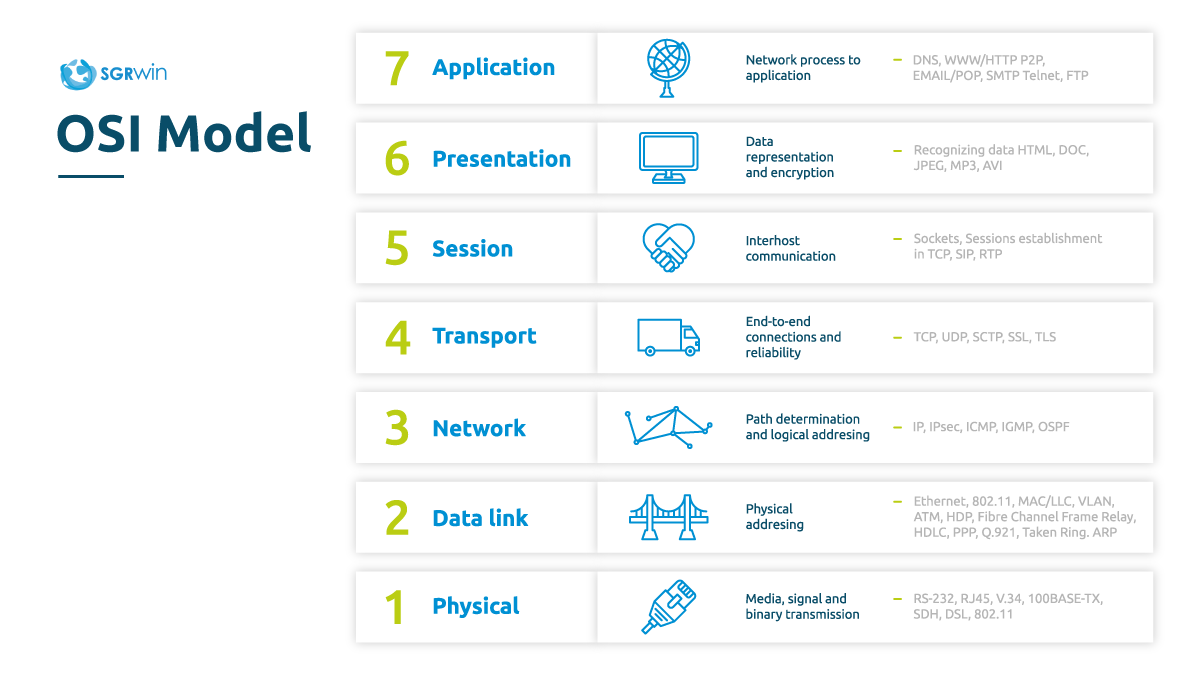04 Nov 2021
Network devices are key connectors to provide communication and interaction between different equipment located in your telecommunication network.
A network contains devices that are connected by cables (wired) or Wi-Fi (wireless), enabling the transmission, exchange and sharing of information.
Network devices are the cornerstone for the transmission of different services
In a computer network, networking equipment provides interconnection to be able to share and receive data between computers, faxes, printers, etc. In other words, network devices facilitate the communication between services and end-users of those services.
A computer network contains equipment (hubs, routers, switches, access points and cables among others) and software (OS or business applications).
Actually, it is confusing to categorise all existing network devices, since each type of network device plays a different role, even when numerous devices or it’s functioning are virtualized or sw based.
Although this all may sound a little confusing, we want you to know about the most outstanding devices. But first, we will introduce you to the OSI model.
OSI model
The Open Systems Interconnection, aka OSI model, is a model created by the International Organization for Standardization which enables the communication between diverse communication systems by using standard protocols.
The purpose of the OSI reference model is to guide vendors and developers so the digital communication products and software programs they create will interoperate and to facilitate clear comparisons among communications tools.
Why OSI model?
- Required for several certification studies.
- The OSI model helps vendors to explain which layer their products work with.
- Helps to understand which protocols and devices can interoperate with each other at different levels.
Depending on the type and characteristics of the device, it can be located at different OSI levels.

For example:
- Hubs and repeaters work at the first, physical layer.
- Bridges, Switches and Access Points are thought of as network devices working at the second data layer.
- Routers work at the third, network layer;
- Gateways are the most complex devices with respect to the functionality and can work at the transport layer and/or session layer.
What are the types of network devices?
Hub
Connects multiple devices to the same network. The Hub sends all the information packets to all the devices on the network connected to it.
Hubs have no intelligence by default to find the best route for packets and cannot filter data. The basic hub is only responsible for retransmitting traffic to all ports, so significant network congestion can occur. Hence, nowadays it is a type of device that is becoming obsolete.
Three types of network hubs exist:
- Active Hubs: Regenerate and retransmit signals in the same way a repeater does. An active hub must be connected to an electrical source because it requires power to amplify the incoming signal before passing it on to the other ports.
- Passive Hubs: Act as connection points and do not amplify or regenerate the signal; the signal only passes through the hub. Passive hubs do not require electrical current to function.
- Hybrid Hubs (smart hub): work as active hubs, but also include a microprocessor chip and have diagnostic capabilities. Smart hubs are more expensive than active ones, but they enable you to connect different types of cables, being also very useful in fault diagnosis and troubleshooting.
Repeater
Repeaters operate at Layer 1 of OSI Model; commonly used to extend the length of the network. They were created to amplify weak signals. Whenever the signal is weak or weakens, then they reproduce it at the actual strength. The basic function of a repeater is to reshape and reamplify the data signal through all network segments.
Modem
A modem is a device that converts digital signals into analog (modulation) and vice versa (demodulation) and thus enables the communication between computers through the telephone line or cable modem. It is used to send the modulating signal through another signal called a carrier. This kind of a device operates on the Physical and Data layers.
Bridge
This network device connects 2 or more network segments, by using MAC addresses for the transfer of data blocks (frames). It allows you to divide a large network into smaller parts. Bridges ensures better performance than a Hub, since bridge filters incoming frames before they are forwarded. However, switch devices are used more, instead of bridges, since they offer more options. Bridges operate on the Physical and Data layers.
Switch
Switches allow you to send and receive information, to access shared resources in a fluid, efficient and secure way. Switches generally offer more intelligent functions than hubs. The switch maintains limited routing information about nodes on the internal network and allows connections to systems such as hubs or routers.
Due to their capacity a virtual circuit switches are more efficient than hubs or routers, improving network security, because virtual circuits are more difficult to analyse.
Switches operate on the Data Link layer or the Network layer of the OSI model, or at both layers together acting as a switch and a router.
There are several types of switches, here the common ones:
- Unmanaged switches
- Manages switches
- Layer 3 switches
- Stackable switches
Access Point
It is a network device that allows you to connect devices to the network wirelessly. It is better known as a wireless access point (WAP) that acts as a transmitter and receiver to create a wireless LAN (WLAN). Using a WAP allows you to create a wireless network on an existing wired network, to support wireless devices and save on cabling costs.
Router
Network device that allows route packets between networks, so computers can be interconnected within the same network framework. It is in charge of establishing the route and to assign it to each data packet within a computer network.
Gateway
Gateways are similar to routers, they are commonly used when route specifications are non-existent and the default alternative is to go through a gateway. They work at the Transport and Session Layers. In the case of a Transport layer there are numerous protocols and standards from different vendors; gateways help to deal with them.
Network Management System is key to managing network devices and even more so when they’re from different manufacturers. SGRwin allows you to completely manage any network device independently of the protocols the manufacturers have used. Our network management system can produce reports, inventory, autodiscovery and device viewer among many other functions! Are your multi-manufacturer network devices wreaking havoc? Are you not sure how many devices are functioning on your network and in what condition they are in? Do you not have autodiscovery?
Don’t sweat it, we have the solutions you are looking for.
